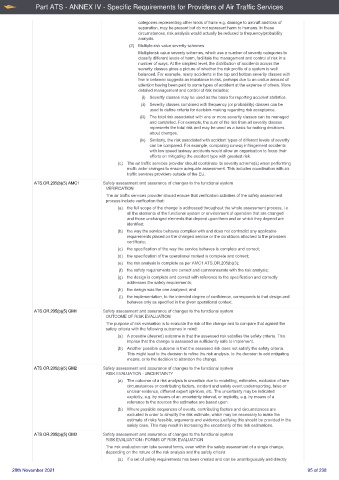Page 95 - UK ATM ANS Regulations (Consolidated) 201121
P. 95
Part ATS - ANNEX IV - Specific Requirements for Providers of Air Traffic Services
categories representing other kinds of harm e.g. damage to aircraft and loss of
separation, may be present but do not represent harm to humans. In these
circumstances, risk analysis would actually be reduced to frequency/probability
analysis.
(2) Multiple-risk value severity schemes
Multiplerisk value severity schemes, which use a number of severity categories to
classify different levels of harm, facilitate the management and control of risk in a
number of ways. At the simplest level, the distribution of accidents across the
severity classes gives a picture of whether the risk profile of a system is well
balanced. For example, many accidents in the top and bottom severity classes with
few in between suggests an imbalance in risk, perhaps due to an undue amount of
attention having been paid to some types of accident at the expense of others. More
detailed management and control of risk includes:
(i) Severity classes may be used as the basis for reporting accident statistics.
(ii) Severity classes combined with frequency (or probability) classes can be
used to define criteria for decision-making regarding risk acceptance.
(iii) The total risk associated with one or more severity classes can be managed
and controlled. For example, the sum of the risk from all severity classes
represents the total risk and may be used as a basis for making decisions
about changes.
(iv) Similarly, the risk associated with accident types of different levels of severity
can be compared. For example, comparing runway infringement accidents
with low speed taxiway accidents would allow an organisation to focus their
efforts on mitigating the accident type with greatest risk.
(c) The air traffic services provider should coordinate its severity scheme(s) when performing
multi- actor changes to ensure adequate assessment. This includes coordination with air
traffic services providers outside of the EU.
ATS.OR.205(b)(5) AMC1 Safety assessment and assurance of changes to the functional system
VERIFICATION
The air traffic services provider should ensure that verification activities of the safety assessment
process include verification that:
(a) the full scope of the change is addressed throughout the whole assessment process, i.e.
all the elements of the functional system or environment of operation that are changed
and those unchanged elements that depend upon them and on which they depend are
identified;
(b) the way the service behaves complies with and does not contradict any applicable
requirements placed on the changed service or the conditions attached to the providers
certificate;
(c) the specification of the way the service behaves is complete and correct;
(d) the specification of the operational context is complete and correct;
(e) the risk analysis is complete as per AMC1 ATS.OR.205(b)(3);
(f) the safety requirements are correct and commensurate with the risk analysis;
(g) the design is complete and correct with reference to the specification and correctly
addresses the safety requirements;
(h) the design was the one analysed; and
(i) the implementation, to the intended degree of confidence, corresponds to that design and
behaves only as specified in the given operational context.
ATS.OR.205(b)(5) GM1 Safety assessment and assurance of changes to the functional system
OUTCOME OF RISK EVALUATION
The purpose of risk evaluation is to evaluate the risk of the change and to compare that against the
safety criteria with the following outcomes in mind:
(a) A possible (desired) outcome is that the assessed risk satisfies the safety criteria. This
implies that the change is assessed as sufficiently safe to implement.
(b) Another possible outcome is that the assessed risk does not satisfy the safety criteria.
This might lead to the decision to refine the risk analysis, to the decision to add mitigating
means, or to the decision to abandon the change.
ATS.OR.205(b)(5) GM2 Safety assessment and assurance of changes to the functional system
RISK EVALUATION - UNCERTAINTY
(a) The outcome of a risk analysis is uncertain due to modelling, estimates, exclusion of rare
circumstances or contributing factors, incident and safety event underreporting, false or
unclear evidence, different expert opinions, etc. The uncertainty may be indicated
explicitly, e.g. by means of an uncertainty interval, or implicitly, e.g. by means of a
reference to the sources the estimates are based upon.
(b) Where possible sequences of events, contributing factors and circumstances are
excluded in order to simplify the risk estimate, which may be necessary to make the
estimate of risks feasible, arguments and evidence justifying this should be provided in the
safety case. This may result in increasing the uncertainty of the risk estimations.
ATS.OR.205(b)(5) GM3 Safety assessment and assurance of changes to the functional system
RISK EVALUATION - FORMS OF RISK EVALUATION
The risk evaluation can take several forms, even within the safety assessment of a single change,
depending on the nature of the risk analysis and the safety criteria:
(a) If a set of safety requirements has been created and can be unambiguously and directly
20th November 2021 95 of 238

